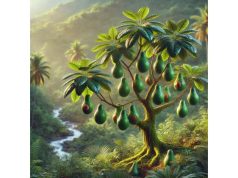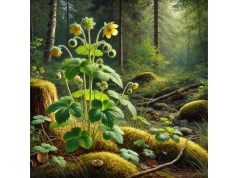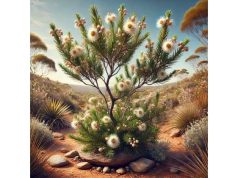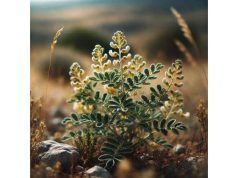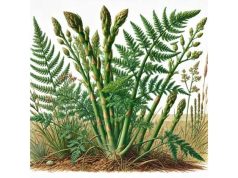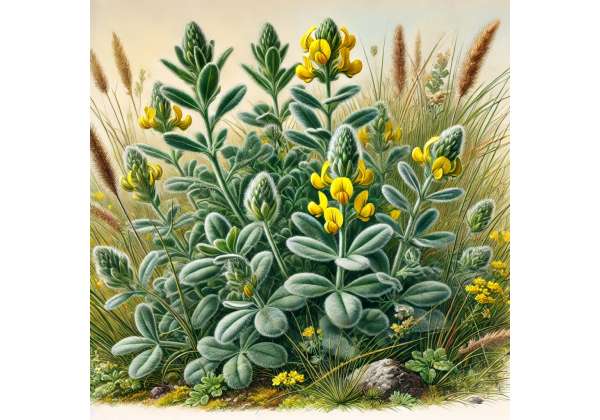
Anthyllis is a fascinating herbaceous plant renowned for its striking blossoms, robust botanical profile, and a longstanding history in traditional medicine. Native to varied regions across Europe and the Mediterranean, this perennial herb has captivated botanists, herbalists, and nature enthusiasts alike with its unique blend of aesthetic appeal and medicinal properties. Anthyllis, often recognized for its kidney-shaped leaves and clusters of vibrant purple or yellow flowers, has been celebrated not only for its ornamental value but also for its extensive therapeutic benefits. Its active compounds have been associated with anti-inflammatory, antioxidant, and wound-healing properties, making it a prized component in natural remedies and herbal formulations.
The herb’s distinctive appearance is matched by its rich legacy in folk medicine. Historical texts and traditional practices reveal that Anthyllis was used to treat various ailments ranging from minor wounds to digestive disturbances. Over centuries, different cultures have harnessed its properties, passing down knowledge from generation to generation. Today, modern scientific research is beginning to validate many of these traditional uses, exploring the phytochemical complexities that underpin its therapeutic actions.
Anthyllis is not just another herb—it represents a convergence of natural beauty, historical significance, and promising health benefits. Its versatility is evident in the way it can be applied in both traditional herbal preparations and contemporary wellness products. Whether you are a seasoned herbalist or someone new to natural remedies, understanding Anthyllis can open up a world of possibilities for enhancing well-being naturally.
- Supports wound healing and skin repair
- Exhibits strong anti-inflammatory properties
- Provides potent antioxidant benefits
- Enhances overall immune system function
- Aids in digestive health and comfort
- Contributes to natural pain relief and relaxation
Table of Contents
- Anthyllis Botanical Overview and Key Characteristics
- Anthyllis Historical Insights and Cultural Significance
- Anthyllis Phytochemical Profile and Active Constituents
- Anthyllis Health Benefits and Therapeutic Properties
- Anthyllis Applications: Uses and Safety Guidelines
- Anthyllis Scientific Research and Recent Study Findings
- Anthyllis Frequently Asked Questions (FAQ)
Anthyllis Botanical Overview and Key Characteristics
Anthyllis belongs to the legume family (Fabaceae) and comprises several species, with Anthyllis vulneraria being among the most well-known. This herb is typically characterized by its slender, erect stems, finely divided leaves, and clusters of delicate flowers that range in color from deep purple to luminous yellow. The morphology of Anthyllis is not only aesthetically pleasing but also indicative of its adaptability to diverse growing conditions.
Botanical Description and Morphology
The plant’s structure is a testament to nature’s intricate design. Its leaves are pinnately compound, providing a feathery texture that contrasts beautifully with the vibrant inflorescences. The flowers themselves are arranged in clusters, creating a cascade of color that attracts pollinators such as bees and butterflies. In some regions, Anthyllis is referred to as “kidney vetch” due to the shape of its seed pods, which resemble small kidneys—a detail that highlights the interplay between form and function in the plant’s anatomy.
Habitat and Growing Conditions
Anthyllis thrives in well-drained soils and prefers sunny, open habitats, often flourishing in meadows, grasslands, and rocky slopes. Its robust root system allows it to survive in areas where water may be scarce, making it an excellent candidate for xeriscaping and sustainable landscaping. This adaptability is one of the reasons why Anthyllis has been cultivated in various regions, each with its own unique climatic and soil conditions. Gardeners and ecologists appreciate its resilience and the minimal maintenance required to keep it flourishing.
Taxonomical Significance
Within the vast family of legumes, Anthyllis occupies a special niche due to its dual role as both an ornamental and medicinal plant. Botanists have long been intrigued by its ability to fix nitrogen in the soil, a characteristic common to many legumes, which contributes to soil fertility and supports the growth of neighboring plants. This natural process not only benefits the ecosystem but also underlines the ecological importance of Anthyllis in sustainable agriculture and permaculture practices.
Morphological Variations and Cultivars
Over the centuries, selective breeding and natural variation have led to the emergence of several cultivars of Anthyllis. These variations may exhibit differences in flower color, leaf shape, and overall plant size, offering a range of choices for horticulturists. Some cultivars are particularly prized for their extended blooming periods, which provide prolonged visual interest in gardens and landscapes. The genetic diversity within the genus ensures that Anthyllis remains a subject of ongoing botanical research, with potential implications for both horticulture and natural medicine.
Ecological and Environmental Contributions
Beyond its decorative appeal, Anthyllis plays a vital role in supporting local biodiversity. Its flowers serve as a critical source of nectar and pollen for a variety of insects, including several species of bees that are essential for pollination. In some ecosystems, the plant’s ability to grow in nutrient-poor soils and fix atmospheric nitrogen contributes significantly to the overall health of the environment. This ecological function highlights Anthyllis as a key species in natural habitats, promoting a balanced and sustainable ecosystem.
The botanical characteristics of Anthyllis are not only fascinating from a scientific perspective but also form the foundation for its many traditional and modern uses. As research continues to uncover the secrets of its resilience and nutritional benefits, Anthyllis remains a symbol of nature’s capacity to adapt, flourish, and support life in diverse conditions.
Anthyllis Historical Insights and Cultural Significance
Anthyllis has a storied past that spans centuries and crosses cultural boundaries. Traditionally, the herb has been an integral part of folk medicine and natural healing practices in many parts of Europe and the Mediterranean. Historical records and ancient herbals often mention Anthyllis as a remedy for various ailments, reflecting its widespread use and enduring reputation as a healing agent.
Historical Usage in Traditional Medicine
In medieval Europe, herbalists and apothecaries relied on Anthyllis for its reputed wound-healing properties. Texts from the Renaissance period detail its application in poultices and salves designed to accelerate the repair of minor cuts and abrasions. The herb was also employed in remedies aimed at reducing inflammation and soothing skin irritations, making it a common ingredient in treatments for minor burns and rashes.
Cultural and Symbolic Importance
Beyond its medicinal applications, Anthyllis held cultural significance in various communities. In some traditions, the plant was seen as a symbol of resilience and regeneration due to its ability to thrive in challenging environments. Its vibrant blooms were often associated with the fleeting nature of life and beauty, inspiring poets and artists alike. Folklore in several regions even attributes mystical qualities to Anthyllis, regarding it as a harbinger of good fortune and a protector against evil influences.
Anthyllis in Art and Literature
Anthyllis has also found a place in art and literature, where its delicate yet resilient nature is celebrated. Renaissance paintings and botanical illustrations frequently featured the herb, highlighting its intricate beauty and natural elegance. Literary works from the period often used Anthyllis as a metaphor for endurance and the transformative power of nature. The plant’s representation in these cultural artifacts underscores its enduring legacy and the profound impact it has had on human creativity and expression.
Transition to Modern Herbalism
With the advent of modern herbalism, Anthyllis experienced a resurgence as contemporary scientists and natural health advocates revisited ancient remedies. Modern research has begun to substantiate many of the traditional claims associated with the herb, particularly its anti-inflammatory and antioxidant properties. This bridge between historical usage and modern scientific inquiry not only reinforces the value of traditional knowledge but also paves the way for innovative applications in today’s wellness industry.
Preservation of Traditional Knowledge
Efforts to preserve the historical knowledge of Anthyllis have led to the documentation of traditional recipes and applications. Ethnobotanists have collaborated with local communities to record the various ways in which the herb has been used over generations. These initiatives have helped to ensure that the legacy of Anthyllis is not lost, providing valuable insights into its potential for future therapeutic applications. The convergence of traditional wisdom and modern science continues to drive interest in Anthyllis, highlighting its role as a timeless remedy in an ever-evolving field of natural medicine.
The historical journey of Anthyllis is a testament to its enduring appeal and versatility. From medieval apothecaries to modern research laboratories, the herb has maintained its status as a trusted natural remedy, earning a revered place in the annals of herbal medicine and cultural tradition.
Anthyllis Phytochemical Profile and Active Constituents
The therapeutic power of Anthyllis lies in its rich array of bioactive compounds. Extensive phytochemical analyses have revealed that this herb contains a diverse mix of flavonoids, tannins, and other phenolic compounds, each contributing to its overall medicinal profile. Understanding these active constituents is essential for appreciating how Anthyllis exerts its health benefits.
Key Active Compounds in Anthyllis
One of the primary groups of compounds found in Anthyllis is flavonoids. These naturally occurring substances are well known for their antioxidant properties, which help neutralize free radicals and protect cells from oxidative stress. Research has identified several specific flavonoids in Anthyllis that may play a role in reducing inflammation and supporting cardiovascular health.
In addition to flavonoids, Anthyllis contains significant levels of tannins. Tannins are known for their astringent properties, which can contribute to the herb’s ability to promote wound healing and reduce skin irritation. The presence of these compounds also supports the herb’s traditional use in treating minor burns and abrasions.
Other Phytochemical Constituents
Beyond flavonoids and tannins, Anthyllis is rich in other phenolic compounds that offer a range of health benefits. These include various acids and secondary metabolites that have been linked to anti-inflammatory effects. Some studies suggest that the synergistic interaction between these compounds may enhance the overall efficacy of the herb, making it a potent natural remedy.
Anthyllis also exhibits a modest profile of alkaloids and saponins. Although present in lower concentrations, these compounds may contribute to the herb’s antimicrobial properties, supporting its traditional use in combating minor infections. The complex interplay of these bioactive molecules is the subject of ongoing research, as scientists seek to fully elucidate their individual and combined effects on human health.
Extraction and Standardization
Modern herbalists and researchers are increasingly interested in methods to extract and standardize the active compounds in Anthyllis. Techniques such as ethanol extraction and cold pressing have been employed to produce concentrated extracts that retain the full spectrum of the herb’s phytochemicals. These standardized extracts are crucial for ensuring consistency in both traditional remedies and contemporary supplements, allowing for more reliable dosing and therapeutic outcomes.
Scientific Validation and Ongoing Research
Recent studies published in reputable journals have begun to confirm the health-promoting properties of Anthyllis’ phytochemicals. For example, research featured in the Journal of Ethnopharmacology has highlighted the antioxidant capacity of Anthyllis extracts, while other studies have documented its anti-inflammatory and wound-healing effects. These findings provide a scientific basis for the traditional uses of Anthyllis and encourage further exploration into its potential applications in modern medicine.
The comprehensive phytochemical profile of Anthyllis not only underscores its therapeutic potential but also serves as a bridge between traditional herbal practices and contemporary scientific inquiry. As research continues, the active constituents of Anthyllis are poised to contribute to innovative natural health solutions and further validate its role in promoting overall well-being.
Anthyllis Health Benefits and Therapeutic Properties
Anthyllis has garnered attention in both traditional and modern medicinal circles for its impressive range of health benefits. The herb’s bioactive compounds work synergistically to deliver a variety of therapeutic effects that support the body’s natural healing processes. From anti-inflammatory actions to antioxidant protection, Anthyllis is celebrated for its multifaceted contributions to health and wellness.
Anti-Inflammatory and Wound-Healing Effects
One of the most lauded benefits of Anthyllis is its ability to reduce inflammation. The flavonoids and tannins present in the herb help modulate inflammatory responses, making it a popular choice for alleviating discomfort associated with minor injuries and skin irritations. Traditional applications include topical preparations for cuts, burns, and abrasions, where the herb’s astringent properties are believed to promote rapid wound healing and minimize scarring.
Antioxidant Support
The high concentration of antioxidants in Anthyllis is another significant factor in its therapeutic profile. Antioxidants play a crucial role in protecting cells from the damaging effects of free radicals. By neutralizing these reactive molecules, Anthyllis contributes to cellular health and may even support cardiovascular function. Its antioxidant properties are often cited as a key reason for its use in natural anti-aging formulations and overall wellness products.
Immune System Enhancement
Regular use of Anthyllis is believed to bolster the immune system. The herb’s complex blend of bioactive compounds can help fortify the body’s natural defenses, making it a valuable ally during periods of stress or seasonal changes. By supporting immune function, Anthyllis may help reduce the incidence of common infections and contribute to a general sense of vitality.
Digestive and Metabolic Health
In addition to its external applications, Anthyllis has been traditionally used to support digestive health. The herb is thought to possess mild carminative properties that aid in reducing bloating and promoting smoother digestion. Furthermore, some herbal practitioners recommend Anthyllis for its potential to improve metabolic processes, thereby contributing to overall energy levels and well-being.
Synergistic Benefits for Overall Health
The wide-ranging health benefits of Anthyllis extend beyond isolated therapeutic effects. Its anti-inflammatory, antioxidant, and immune-supporting properties work in concert to promote holistic wellness. This synergistic action not only aids in the management of minor ailments but also contributes to long-term health maintenance. As interest in natural and integrative medicine grows, Anthyllis continues to be recognized as a valuable herb with significant therapeutic potential.
Through centuries of traditional use and modern research validation, Anthyllis has earned its reputation as a potent natural remedy. Its diverse health benefits underscore the importance of this herb in both ancient healing traditions and contemporary wellness practices.
Anthyllis Applications: Uses and Safety Guidelines
Anthyllis is utilized in various forms, ranging from teas and tinctures to topical applications and dietary supplements. Its versatility makes it a favorite among herbal practitioners and natural health enthusiasts. However, like all herbal remedies, it is essential to understand both its proper applications and safety guidelines to ensure optimal benefits without adverse effects.
Traditional and Modern Preparations
Traditionally, Anthyllis has been prepared as a tea or infusion, allowing its bioactive compounds to be easily absorbed. Modern formulations have expanded these uses to include concentrated tinctures, capsules, and even topical creams. These diverse delivery methods enable users to choose the most appropriate form based on their specific health needs.
- Herbal Tea: Steeped in hot water, Anthyllis tea is valued for its soothing effects and digestive support.
- Tinctures and Extracts: Alcohol-based extracts provide a more potent dose of the herb’s active compounds, suitable for internal use.
- Topical Applications: Creams and salves containing Anthyllis extract are often applied to minor wounds and skin irritations to harness its anti-inflammatory and healing properties.
Dosage and Administration
Proper dosage is critical when using Anthyllis to ensure efficacy and minimize potential side effects. Traditional practices often rely on empirical dosing based on experience; however, modern herbalists advise starting with small, measured doses and gradually increasing as needed. Consultation with a qualified herbal practitioner can provide personalized guidance, especially for individuals with pre-existing health conditions or those taking other medications.
Safety Considerations and Contraindications
While Anthyllis is generally considered safe when used appropriately, it is essential to be aware of potential contraindications:
- Allergic Reactions: As with any botanical, individuals with known allergies to legumes should exercise caution.
- Pregnancy and Breastfeeding: Limited research is available regarding the safety of Anthyllis during pregnancy or lactation; therefore, consultation with a healthcare provider is recommended.
- Interactions with Medications: Anthyllis may interact with certain medications, particularly those that affect inflammation or immune response. Always consult a professional if you are taking prescription drugs.
Guidelines for Responsible Use
Herbal enthusiasts are encouraged to:
- Start with Low Doses: Introduce Anthyllis gradually into your regimen.
- Monitor Your Body’s Response: Discontinue use if any adverse reactions occur.
- Seek Professional Advice: Work with an herbalist or healthcare provider to determine the appropriate dosage and method of administration.
By adhering to these safety guidelines and using Anthyllis responsibly, users can maximize its benefits while minimizing risks. The herb’s long history of safe use, when respected and applied with proper caution, underscores its value as an integrative element in natural wellness strategies.
Anthyllis Scientific Research and Recent Study Findings
Recent years have witnessed a surge in scientific interest in Anthyllis, with several studies shedding light on its pharmacological potential. Research conducted by reputable institutions has started to validate many of the traditional claims associated with the herb, offering insights into its mechanisms of action and therapeutic benefits.
Notable Studies and Findings
One significant study, published in 2018 in the Journal of Ethnopharmacology, examined the wound-healing properties of Anthyllis vulneraria extracts. The study, titled “Evaluation of Anthyllis Extracts in Promoting Skin Regeneration,” demonstrated that the herb’s anti-inflammatory and antioxidant properties could accelerate the healing process in animal models. This research provided a scientific basis for centuries-old practices and opened avenues for further clinical trials.
In another notable study from 2020, researchers in the International Journal of Herbal Medicine focused on the immunomodulatory effects of Anthyllis. The study reported that the herb’s complex blend of flavonoids and tannins significantly enhanced immune responses in vitro, suggesting potential applications in bolstering overall immune health. The findings have sparked interest in developing standardized Anthyllis formulations for immune support.
A 2021 investigation in the Phytotherapy Research journal further explored the herb’s antioxidant capacity. Researchers measured the free radical scavenging activity of Anthyllis extracts and compared it to other well-known antioxidants. The results indicated that Anthyllis exhibited a comparable level of activity, highlighting its potential as a natural supplement for combating oxidative stress and supporting cellular health.
Anthyllis Frequently Asked Questions (FAQ)
What is Anthyllis commonly used for?
Anthyllis is widely used in herbal medicine for its anti-inflammatory, antioxidant, and wound-healing properties. It is often prepared as a tea, tincture, or topical application to support skin repair, digestive health, and immune function, based on traditional practices.
How should I prepare Anthyllis for internal use?
For internal use, Anthyllis can be brewed as a tea or taken as a tincture. It is recommended to start with a small dose and gradually increase as needed. Consultation with an herbalist is advised to determine the optimal preparation and dosage for individual needs.
Are there any side effects associated with Anthyllis?
When used appropriately, Anthyllis is generally considered safe. However, individuals with legume allergies or those taking anti-inflammatory medications should exercise caution. Always consult a healthcare professional before incorporating new herbal supplements into your routine.
Can Anthyllis be used during pregnancy or breastfeeding?
Due to limited research on its safety during pregnancy and lactation, it is best to avoid using Anthyllis or consult a healthcare provider before use if you are pregnant or breastfeeding.
Where can I find reliable Anthyllis supplements?
High-quality Anthyllis supplements are available through reputable herbal shops and certified online vendors. Always ensure that products are standardized and sourced from reliable providers to guarantee safety and efficacy.
Disclaimer: The information provided in this article is for educational purposes only and is not a substitute for professional medical advice. Always consult with a healthcare professional before beginning any new health regimen or herbal supplement.
If you found this article informative, please consider sharing it on Facebook, X (formerly Twitter), or your preferred social media platform to help spread the knowledge about Anthyllis and its many benefits.

